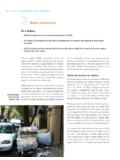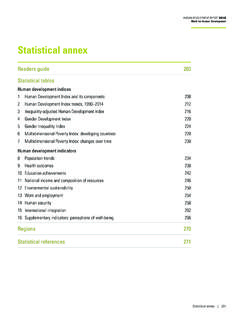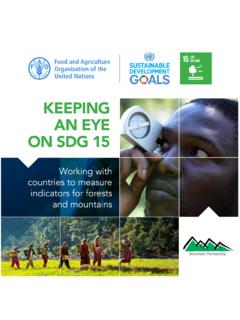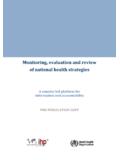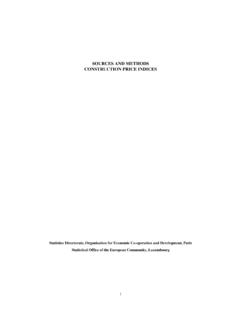Transcription of Evidence of Crisis and Analysis of Contributing Factors
1 The State of theHealth Workforce inSub-Saharan Africa: Evidence of Crisis and Analysisof Contributing FactorsBernhard LieseThe World Bank/Georgetown UniversityGilles DussaultThe World BankAfrica RegionThe World BankWashington, Region Human DevelopmentWorking Paper SeriesiiCopyright September 2004 Human Development SectorAfrica RegionThe World BankThe findings, interpretations, and conclusionsexpressed herein are entirely those of the authors They do not necessarily represent the views of the World Bank Group, its ExecutiveDirectors, or the countries that they representand should not be attributed to design by Word ExpressTypography by Word Design, photo: Table of ContentsForeword ..vAcknowledgements .. Estimates of the Health Sector Workforce .. in the Health Workforce .. Imbalances .. of Economic Reform Processes .. Migration of Health Professionals.
2 12 Factors Contributing to Emigration .. of HIV/AIDS on the Health Sector .. the Millennium Development Goals ..22 Annex ..24 Notes ..38 References ..39 FiguresFigure 1: Average Health Workforce Availability ..4 Figure 2: Trend of Africa s Physician to Population Ratio ..6 Figure 3: Trend of Africa s Nurses to Population Ratio ..7 Figure 4: Niger Health Personnel Distribution by Region ..9 Figure 5: Health Personnel from Zambia and Zimbabwe Registered in the UK ..13 Figure 6: Health Personnel in South Africa 1996 vs. 2001 ..15 Figure 7: Proportion of Health Workers Who Intend to Migrate ..15iiiivFigure 8: Distribution of Increased Labor Costs due to HIV/AIDS in Zimbabwe ..18 Figure 9: Projected Health Workers with AIDS in Botswana ..18 Figure 10: Estimates of Shortages of Health Workers in SSA ..21 BoxesBox 1: Malawi Faces Grave Health Personnel Shortage.
3 3 Box 2: The Impact of Structural Adjustment Programs in Cameroon and Ghana ..11 Box 3: Ghana s Loss of Health Sector Workers ..14 Box 4: Impact of HIV/AIDS on Kenya s Health Workforce ..19 TablesTable 1: Classification of Sub-Saharan Countries by HRH Ratios and Languages ..5 Table 2: Projection of the Cost of the Health Personnel Brain Drain for Ghana ..16 Table 3: WHO Estimates of Health Personnel per 100,000 Population for SSA ..24 Table 4: WHO Estimates of Health Personnel per 100,000 Population, Averages ..26 Table 5: Trends in Physicians 1960-1998 ..26 Table 6: Trends in Nurses 1960-1998 ..27 Table 7: Health Personnel Statistical Database ..28 Table 8: Brain loss in 9 SSA countries, by profession ..35 Forewordhe declaration and acceptance of theMillennium Development Goals her-alded renewed commitment by coun-tries and the international communityto work towards the achievement of a betterquality of life for all the people of the develop-ing world.
4 At least 4 of the 8 goals are healthrelated and provide the impetus for govern-ments, bilateral and multilateral developmentagencies working in the health sector to devel-op effective strategies to attain these , for many African countries, it will behard, if not impossible to achieve the goalsby 2015. The key obstacle is now recognizedas the lack of a stable human resource base inthe health sector. Absolute shortages, internaland external migration, inadequate remuner-ation and incentive mechanisms, maldistribu-tion and training and education issues ofhealth workers, as well as macroeconomicpolicy constraints (often highlighted by theBank, the Fund and other internationalfinancial institutions) are identified as rootcauses for the present situation. The realiza-tion that there are health work-force issues ofsuch serious dimensions has led the usage ofthe phrase The African health workforcecrisis.
5 This report is an attempt to systematicallydocument and evaluate the state of the healthworkforce in Africa. It draws on academicpublished literature (which is limited), theWHO statistical database (which is incompleteand only sporadically updated), studies ofbilateral donors , national documents, andnewspaper articles. The report shows clearlythat for more than a decade HR issues havereceived very little attention. Ministries ofFinance often consider HR as a recurrentexpenditure and a drain on the budget ratherthan a critical investment and input to theattainment of positive health outcomes. Demo-tivation of the health workforce has reachedalarming levels and resulted in their migrationto the developed world. Increasing nursingshortages in many high income countries suchas the UK, USA, France, and Canada have ledto a dramatic increase in emigration of highlyskilled health personnel particularly fromAnglophone and now from Francophonecountries in situation has been compounded by theHIV/Aids epidemic which has put additionalstrains on the health care sector.
6 The diseaseburden has escalated, productivity of healthworkers has diminished and a great number ofvTvihealth workers have succumbed to the epidem-ic, thus aggravating the Crisis . The report shows that Africa faces a crisisand offers recommendations for action. It sug-gests the need to recognize the importance toalign health sector, civil service and macroeco-nomic policies; it stresses that countries mustoffer internally competitive wages and nonfi-nancial incentives; and proposes to invest intotraining that is specifically oriented to theneeds of national markets. Our hope is that thereport will stimulate further work on thisimportant PannenborgSenior Health Advisor and Sector Leaderfor Health, Nutrition and PopulationHuman DevelopmentAfrica RegionviiAcknowledgementWe would like to thank our colleagues, Christoph Kurowski and Demissie Habte, for shar-ing their data and experience and their guidance.
7 We would also like to thank Ying Zhou,who provided superb research support, and Elsie Lauretta Maka, who has overseen the pub-lication of this 1 Introductionn 2000, all 189 United Nations mem-ber states endorsed the MillenniumDevelopment Goals (MDGs). This rep-resented an unprecedented agreementwithin the development community about keydevelopment outcomes (OECD, 2002). TheMDGs are a set of 8 goals, 18 targets and 48performance indicators relating to povertyreduction by 2015. Of these goals, four aredirectly related to better health outcomes: two-third reduction of infant and under five mor-tality, three-fourth reduction of maternal mor-tality, halt and reverse HIV/AIDS, tuberculosis,and malaria epidemics, and halve the propor-tion of people suffering from hunger. By someestimates, US$46 billion per year is required toscale up health services in low-income coun-tries (WHO CMH, 2001).
8 The majority ofthese funds would be used to expand thecapacity of human resources in health,1as thisis a prerequisite for increasing the access toessential health services and for bringing downthe disease burden to the level of the MDGs(WHO CMH, 2001).This paper examines some of the issues ofhuman resources in the health sector, focusingon the situation in Africa in view of its partic-ularly critical state. First, we examine the cur-rent state of the health sector workforce,including the latest statistics and trends. Sec-ond, we analyze the economic Factors thatinfluence the availability of human , we take a close look at the brain lossphenomenon, or exodus of trained health careprofessionals from the country or from the sec-tor. Then, a discussion of the impact of theHIV/AIDS epidemic on the workforce itselfand working conditions follows.
9 Last, we con-clude with some issues that governments anddevelopment partners need to tackle to addressthe growing human resources Crisis in theAfrican health 2 Country Estimates of the Health Sector Workforcep-to-date reliable statistics on humanresources for health (HRH) in Africaare scant, and when available theyremain difficult to standardize andcompare this datachallenge, published figures of health person-nel to unit population ratios from the 1960sthrough the mid-to-late 1990s and somemore recent figures clearly indicate that aserious Crisis in human resources exists. Thesevere shortage and imbalanced distribution oftrained health personnel poses a serious obsta-cle to the achievement of the MDGs and to theimprovement of the overall health of the is a quantitative overview of the extent ofthis WHO StatisticsThere are a range of indicators that measurethe level of human resources employed in acountry s health services.
10 The principal indica-tor is the stock of health personnel, typicallymeasured as the proportion of health workersamong the total population. Though this indi-cator is theoretically simple, there are a num-ber of practical difficulties when comparing itacross countries. Occupational classificationsare country specific, as well as the methodused to count the number of such persons ineach occupations (such as the distinctionbetween headcount data and full-time equiva-lent data) (Diallo et al., 2003). Further, theactual roles and scope of practice of healthcare workers also vary, making them difficultto compare. Finally, this indicator depends onthe accurate measurement of the denominator, total population. In many low-incomecountries, and especially in Africa, census datado not exist and when they do are often care-related occupations are mainlycategorized under two groups according to theInternational Standard Classification of Occu-pations:1.










